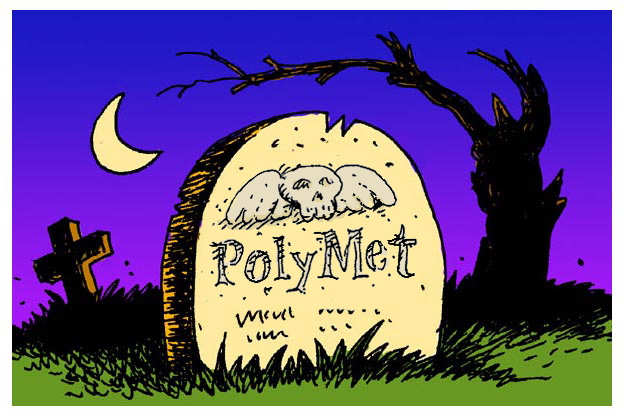

Perpetual Care
It’s not just for cemeteries anymore!
There are stories on stories about pollution from sulfide mines, such as the ones currently proposed in northern Minnesota, that continues long — really long — after the mines themselves close. The continued monitoring, prevention, and cleanup of pollution from sulfide mines is a substantial expense that has to be considered in assessing the true cost, and value, of a mine.
At the risk of mixing some imagery here, when you host a big meal, afterwards some people will say, “Let us help you clean up,” and some will say they’re paying for a babysitter (even if the kids are in their 20s) and head for the the door.
Guess which category mining companies fall into? They want to chow down, but they want somebody else to do the dishes. And that, kids, is you and me.
There is a term I heard recently for washing up the mining companies’ dishes: perpetual care. It is like the dirty dishes that never end.
When a mine is played out or becomes uneconomical to operate, the revenue stops, but from an environmental problems standpoint, it is just a gift that keep on giving. Sometimes, in fact, it takes a while after a mine is closed and its “reclamation” is finished that the problems start to show up.
An example of that is a mine that has been touted by the mining industry as a model of extraction without environmental harm, the Flambeau mine in Wisconsin. That seemed to be true shortly after the mine was closed but a few short years later, levels of copper and zinc toxic to aquatic life were found in half the samples of surface water surrounding the mine.
The Flambeau mine, operated for only five years, was tiny (32 acres, I think), dwarfed by the proposals of PolyMet and Twin Metals Minnesota. Yet, the Flambeau Mine, the industry’s poster child, was found by a federal court in July, 2012 to have violated the Clean Water Act several times.
How often do water quality problems exceed the estimates contained in Environmental Impact Statements? Almost always.
When you open a sulfide mine, perhaps 99 percent of what you extract is waste, either just waste rock or tailings. Tailings are ground up waste from processing ore into a concentrate to send to the smelters, the real shit holes in our story.
Anyway, where was I? Oh, yes: after you dig up all this rock and pulverize some of it, well, it doesn’t go away. Sadly, for everybody concerned. So what do you do with it?
Well, you might construct Brimstone Mountain, as Polymet proposes to do with the waste rock from the Great Sulphur Hole it proposes to dig at Hoyt Lakes. Even Polymet says that Brimstone Mountain will leach sulphuric acid and heavy metals into the water for 200 years.
A common approach to dealing with tailings, which PolyMet also proposes, is to construct a tailings basin and — I’m not kidding here — cover the tailings with water. I truly could not believe that somebody would take rock that only requires water and a little air to make sulphuric acid and, yes, cover it with water. This is genius.
But this is what our Neighbors To The North do at Lake Shebandowan for an abandoned underground sulfide mine there. Scroll down to page 141 of this report to see. And they are by no means the only ones. When water gets too high in the tailings basin, when it rains a lot or you have some snow melt, the excess flows into the spillway — which is a wonderful term, don’t you think — where it is carefully monitored by Ontario’s Industrial Sewage Works — I’m not making this up; I couldn’t — on its way to Lake Superior. No mention is made in the report about the sulphuric acid that leaks directly into the groundwater. I guess that never happens. They did line the basin with plastic, after all.
If the water gets too low, I suppose they pump some out of Lake Shebandowan to fill it up! Well, they have to, because exposing wet tailings to air will make sulphuric acid extra fast. Sorry smallmouth bass in Lake Shebandowan!
All in all, a great solution. Just think, maybe someday, Birch Lake can have its own spillway, too!
But, I digress. The subject is perpetual care. But Lake Shebandowan is an example of the efforts that are required after a mine shuts down, regardless of whether you think these efforts are adequate. And unsurprisingly, mine owners can’t or won’t do it. The EPA estimates the cost of cleanup that the mining companies won’t do is twenty billion dollars.
In Minnesota, when an operator closes up and walks away from a mine, it is supposed to be” maintenance free.”
But I suspect that we’ll all be mowing the lawn over PolyMet’s — or Twin Metals Minnesota’s — grave for a long time.
Update: Why kids, do you suppose the Shebandowan tailings containment basin spillway is to a stream leading to Lake Superior? Because, it is just like flushing the toilet. Which is why a tailings containment basin spillway for the Twin Metals Minnesota project would probably really be to the Kawishiwi River, not Birch Lake.
Thanks for your feedback. If we like what you have to say, it may appear in a future post of reader reactions.

